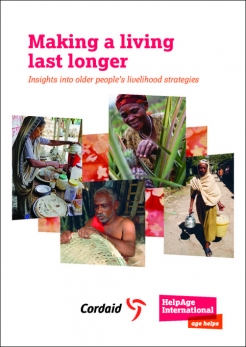 By Rosaleen Cunningham
By Rosaleen Cunningham
On International Workers Day, we highlight a new report that focuses on older people’s livelihoods in developing countries.
Making a living last longer shows the significant barriers older people around the world face in trying to make a living.
Debt and lack of access to microfinance and microcredit are some of the biggest challenges.
Its findings show older people’s strategies for making a living include working, taking out loans from both formal and informal sources, receiving money from children and other family members, and begging.
Despite the international-feted successes of microfinance institutions and banks, older people have had only limited access to these credit and savings facilities.
Instead older people have to rely on loans, though reluctantly, from moneylenders and pawnbrokers.
Fear of debt
The study found a universal fear among older people of violent reprisals or repossession of assets for non-payment of loans.
In Ethiopia, one older man told us: “We will not borrow from them because we are fearful of repercussions for late or non-payment and the loss of our reputation if we are not able to repay.”
Older people from Tanzania, agreed, explaining they are reluctant to approach formal lending institutions: “We are afraid to approach them because some days we go without a meal, so how can we possibly repay? We are afraid of being imprisoned if we cannot repay.”
One older person in Bihar, India said: “If you are unable to repay a loan, you are as good as dead.”
Susan Erb, the report’s author said: “High rates of interest, strict and inflexible repayment conditions, monthly service charges, and high minimum loan amounts (by banks in particular) exclude older people from using formal institutions.”
Older women and widows left out
The report also confirmed that the burden of securing a sustainable livelihood was felt most keenly by widowed women.
For example in investigating informal lending between neighbours, the report’s author found that in India, Tanzania and Bangladesh women were consistently unable to access the same loan amounts as men.
Older women reported that loans taken from neighbours by men were up to 10 times higher than those taken by women.
One size does not fit all
The report highlighted evidence that cash transfers and pensions offer vital support for older people and can help them to diversify their opportunities by providing income to buy assets or for investing in their businesses.
But pensions were only a partial solution – the findings indicated that pensions were typically not large enough to be the full answer.
Older people’s associations were one avenue through which older people improved their opportunities to achieve a sustainable livelihood.
The study concludes that there is no single form of livelihood intervention that is appropriate for all older people.
“Interventions aimed at improving older people’s livelihoods must vary according to location, situation, and older people’s preferences and priorities,” says Astrid Walker-Bourne HelpAge International’s Head of Policy.
The study was conducted by HelpAge International, Cordaid and partners and involved 1,000 older men and women in Bangladesh, Ethiopia, India and Tanzania.
Download Making a living last longer: insights into older people’s livelihoods strategies (622kb)
